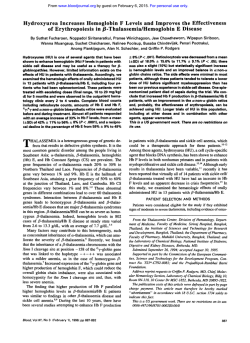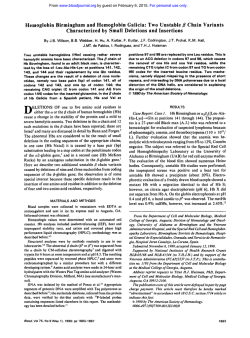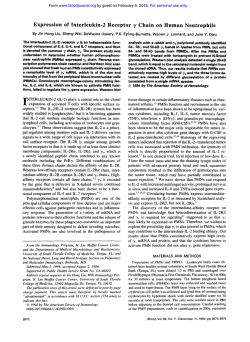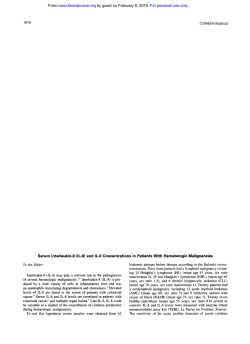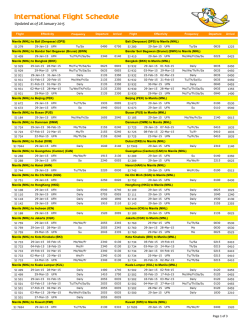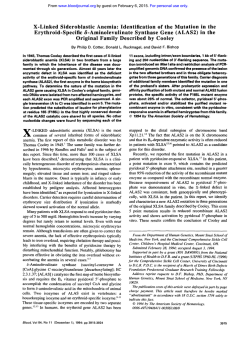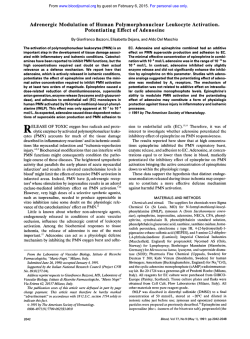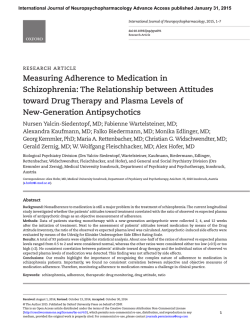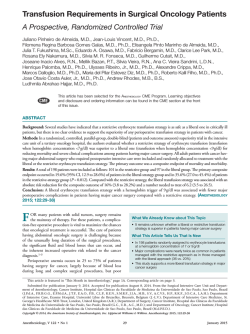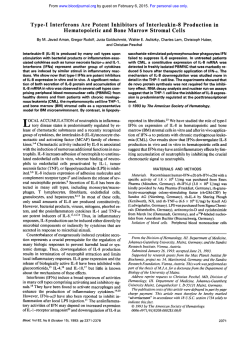
Hemoglobin Stimulates Mononuclear Leukocytes to Release
From www.bloodjournal.org by guest on February 6, 2015. For personal use only. Hemoglobin Stimulates Mononuclear Leukocytes to Release Interleukin-S and Tumor Necrosis Factor Q! By Steve J. McFaul, Phil D. Bowman, Vilmar M. Villa, Marcelina J. Gutierrez-lbanez, Maria Johnson, and Dan Smith Incubation of human mononuclear leukocytes (MNL) with human stroma-free hemolysate (SFH), purified adult hemoglobin Ao (HbAo), andoxidized HbAo (METHb) causedMNL t o release compoundsinto the supernate that mediated neutrophil (polymorphonuclear leukocytes, PMN) chemotaxis and PMN adherence t o human umbilical vein endothelial cells (HUVEC). Chemotaxis and PMN adherence t o HUVEC were reduced significantly when supernates were preincubated with neutralizing antibodies t o interleukin-8 (IL-8) and tumor necrosis factor (U (TNF-m), respectively, suggesting that 11-8 and TNF-a played significant roles in mediating these activities, Greatest chemotactic activity was observed in supernates of MNL treated with HbAo; while greatest PMN/endothelial cell (EC) adherence activity was observed in supernates of MNL treated with METHb. Furthermore, PMN/EC adherence activity was a function of METHb con- tent in each hemoglobin solution. PMN chemotaxis, PMN adherence t o HUVEC, and cytokine release increased as a function of increasing incubation time. Chemotactic activity was detected in HbAo-treatedand METHb-treated MNL supernates after incubation for 6 hours and was maximal by 10 hours. 11-8 was detected in both HbAo and METHb-MNL supernates by 4 hours. PMN/EC adherence activity was detected in HbAo-MNL supernatesat 10 hours and in METHbMNL supernates at 4 hours. TNF-(Uwas detected in METHb and HbAo-MNL supernatesat 4 and 12 hours, respectively. These results suggest that hemoglobin solutions stimulate MNL t o release IL-8 and TNF-a in quantities sufficient to induce PMN chemotaxis and PMN adherencet o HUVEC. This is a US government work. There are no restrictions on its use. C produce a variety of side effects in vivo. Two types of cells that hemoglobin solutions contact immediately following infusion are leukocytes and endothelial cells. Both of these cell types play major roles in modulating a number of hematologic events including blood clotting, antibody production, and sequestration of monocytes and neutrophils from the circulation into the tissues, which is characteristic of the inflammatory response.I3 Furthermore, mononuclear leukocytes (MNL, monocytes and lymphocytes), polymorphonuclear leukocytes (PMN, neutrophils), and endothelial cells (EC) respond to various stimuli by releasing cytokines that alter the behavior of target cells. The data from earlier studies indicate also that hemoglobin solutions must be extremely low in endotoxin and phospholipid impurities for results to be interpreted without ambiguity. This is particularly true when looking at the interaction of hemoglobin solutions and leukocytes since monocytes are stimulated to release cytokines and prostaglandins by low levels of endotoxin. Therefore, we developed a protocol for preparing solutions of SFH and HbAo that do not contain measurable quantities of endotoxin and phospholipid^.'^ Using these solutions, we examined whether hemoglobin ELL-FREE HEMOGLOBIN is a potentially useful oxygen-carrying blood substitute that obviates the need for blood typing, could be prepared free of human immunodeficiency and hepatitis viruses, and would have a considerably longer storage life than whole blood. Early in the development of a hemoglobin-based blood substitute, however, hemoglobin solutions were found to be toxic when administered to animals.’.’ Subsequently, Rabiner et a13 showed that residual fragments of the erythrocyte membrane (“stroma”) present in the earlier hemoglobin preparations were toxic. Removal of the stroma, however, did not render hemoglobin preparations free of side effects. When infused into animals, preparations of stroma-free hemolysate (SFH) have demonstrated a variety of toxic effects including disseminated intravascular coagulation,“ liver necrosis,5 vasoconstriction,6and effects on renal hemodynamic^.^ Furthermore, when a very low dose of SFH was administered to eight men in a clinical trial, they exhibited transient bradycardia, mild hypertension, decreased urine output and endogenous creatinine clearance, and a mild prolongation of the activated partial thromboplastin time during the SFH infusion and several hours thereafter.8 These results prompted several investigations into the source of the toxicities. Feola et al9*I0 showed that bovine hemoglobin itself was not toxic to rabbits and did not stimulate endothelial cells to release prostaglandins. Rather, it was endotoxin and phospholipid impurities that gave rise to toxicity and cell activation. In contrast, however, Macdonald et a l l ’ showed that high pressure liquid chromatography (HPLC) purified human adult hemoglobin Ao (HbAo) evoked a slow rise in coronary resistance (vasoconstriction) in isolated perfused rabbit hearts. These solutions were below detectable limits of endotoxin and phospholipids. Furthermore, Smith et a l l 2 showed that preparations of HbAo with endotoxin levels less than 0.12 endotoxin units (EU)/ mL activated complement from human plasma and stimulated human monocytes to express procoagulent factors on their surface. Taken as a whole, these data suggest that purified HbAo can exert direct effects on various cell types, which can Blood, Vol84, No 9 (November l), 1994 pp 3175-3181 From theLetterman Army Institute of Research, Division of Blood Research, Presidio of San Francisco, CA; USAlSR, SGRD-ULM-T, Ft. Sam Houston, TX; and Alliance Pharmaceutical, San Diego, CA. Submitted April 4, 1994; accepted July 12, 1994. The opinions and assertions contained herein are the private views of the authors and are not to be construed as ofJicial nor do they reflect the views of the Department of the Army or the Department of Defense (AR360-5). Address reprint requests to Steve J. McFaul, PhD, Walter Reed Army Institute of Research, Blood Research Detachment, Washington, DC 20307-5100. The publication costs of this article were defrayed in part by page charge payment. This article must therefore be hereby marked “advertisement” in accordance with 18 U.S.C. section I734 solely to indicate this fact. This is a US government work. There are 110 resm’ctions on its use. 00W-497I/94/8409-0033$0.00/0 3175 From www.bloodjournal.org by guest on February 6, 2015. For personal use only. McFAUL ET AL 3176 stimulated MNL to release substances that mediate two critical events in an inflammatory response: PMN adherence to endothelium and PMN chemotaxis. PMN adherence is considered to be the primary step of an inflammatory re~ponse"*'~ because cells must attach to the endothelium before they can enter into the tissues. The presence of a chemotactic substance in the tissues then promotes the movement of PMNs through the endothelial lining. We found that when exposed to hemoglobin solutions that contained less than 0.06 EU/mL of endotoxin, MNL released cytokines that promoted both PMN adherence to endothelial cells and PMN chemotaxis. MATERIALS AND METHODS Reagents All reagents used in the preparation of hemoglobin solutions were of the highest grade available. RPM1 1640 medium without phenol red, glutamine, antibiotic-antimycotic mixture (loox), and 1 m o m HEPES were purchased from Gibco BRL (Grand Island, NY). Human serum albumin (HSA, 25%) was purchased from Miles, Inc (Elkart, IN). Quantikineenzyme-linkedimmunoassay kits for interleukin-8 (IL-8) and tumor necrosis factor a (TNF-a),and neutralizing antibodies toward IL-8 and TNF-a! were purchased from R & D Systems (Minneapolis, MN). Hemoglobin Preparation Stroma-free hemolysate and purified HbAo were prepared from outdated human packed red blood cells in a pilot plant production facility as described by Winslow and Cha~rnan.'~ The final concentration of SFH was 60 mg/mL,buttheHbAowasconcentrated further to 250 mg/mL using a Clirans C081 hollow fiber type dialyzer, 0.8' (TerumoCorp,Tokyo,Japan)attached to a vacuum. Solutions of SFH and HbAo were made isotonic by the addition of lox Hanks' balanced salt solution(HBSS). Penicillin G, streptomycin sulfate, amphotericin B, and HEPES were added to final concentrations of 100 U/mL, 100 pg/mL, 0.25 pg/mL (1X antibiotic-antimycotic solution), and 25 mmoVL, respectively. Solutions of SFH and HbAo were stored frozen at -20°C and -8O"C, respectively as 10-mL aliquots. The aliquots were thawed in a 37°C water bath as needed. Stroma-free hemolysate and HbAo were partially oxidized to 2% and 7% methemoglobin, respectively, when frozen. Methemoglobin levels rose to 7% and 14% for SFH and HbAo, respectively, duringthe%monthperiod of research. This gradualincreasein oxidation did not alter results from those seen when both hemoglobin solutions were freshly prepared. Methemoglobin. HbAo was oxidized to methemoglobin (METHb) by the slow additionof potassium ferricyanide K3Fe(CN)6 at a ratioof 1.2 mol of K,Fe(CN), to 1 mol of heme.The K,Fe(CN), was dissolved in 100 pL of HBSS, and four 25-pL aliquots were added to the HbAo solution at 10-minute intervals. The HbAo was rocked gently and maintained4°C at during the process. The METHb wasthensterile-filtered,and excess K,Fe(CN)6wasremovedby bed resin passing the METHb through an analytical grade mixed (AG 501-X8 (D); Bio Rad, Richmond, CA). The resin was poured in a sterile syringe barrel in a laminar flow hood, and was washed with several column volumes of sterile pyrogen-free water just before addition of the METHb. These precautions were takento minimize endotoxin contamination. The METHb effluent was collected, made isotonic with the addition of1OX HBSS, supplemented with 25 mmoVLHEPES and antibiotic-antimycotic solution, sterile filtered, and stored at 4°C. All METHb analyses were performed on a COBAS automatic analyzer usingthe method of Evelyn-Malloy." Final endotoxin levelsof SFH, HbAo, and METHb solutions were <O.M EU/mL using the gel-clot limulus amebocyte lysate assay (BioWhittaker, Inc). The sensitivity of this assay was not affected by the presenceof hemoglobin. Phospholipids were undetectable by thin layer chromatography and phosphorous analysis. Leukocyte Isolation MNL were isolated from the blood of healthy volunteers. Blood was drawninto EDTA Vacutainer tubes and layered over Histopaque 1077 (Sigma, St Louis, MO) at a blood-to-Histopaque ratio of 2:l. The mixture was centrifuged for 20 minutes at 300 X g at room temperature in a swinging bucket rotor.The MNL band at the interface wasremovedwith a pipet,washedtwicein HBSS without calcium and magnesium(HBSS-), then resuspended in 2mL HBSSand maintained on a rocker until used.MNL contained 20% monocytes and 80% lymphocytes. PMNs were isolated by the method of McFaul." Human blood was collected into EDTA Vacutainer tubes and 30 mL were layered onto 15 mL of Mono-Poly Resolving Medium (MPRM) (ICN Biomedicals, Inc, Irvine, CA) in a sterile conical polypropylene tube. The blood was centrifugedfor 50 minutes at 750 x g and the PMN band (band 2 from top) was removed using a syringe and 18 gauge needle. Contaminating erythrocytes were removed from the PMN suspension by underlayering the suspension with 5 mL of MPRM and centrifuging it for 15 minutes at 750 X g and the PMNs were collected from the upper phase and were washed twice with HBSS-, then resuspended in HBSS. Cells were maintained on a rocker at room temperature until used. The PMN band contained greater than 96% neutrophils. Viability of both cell types was >98% by trypan blue exclusion. MNL Incubation Unlessotherwisenotedinthelegend, 8 X l@ MNUmL were suspended in multiwell plates with RPM1 1640 medium containing 25 mmol/L HEPES buffer,100 U/mL penicillin G, 100p@mLstreptomycin sulfate, 2.5 pg/mL amphotericin B (RPM complete), and differenttreatments as indicatedinthelegends. The suspensions were incubated with gentle shaking for 1 to 14 hours at 37°C and 5% CO2. The plates were centrifuged and the supernates were transferred to sterile multiwell plates and kept frozen ateither -20°C or -80°C until used. PMN Chemotaxis Chemotaxis was assayed according to a modification of the procedure of Megyerietwhichisbased on the migration of PMNs through 3.0 pm pores inp~ly~arbonate membranes of Transwell cell culture inserts (Costar Inc. Cambridge, MA).MNL supernates (300 pL) were placed into the inner 12 wells of 24-well plates, and 300 pL of RPM complete media containing 0.25% HSA (RPMUHSA) were added. Then 50 pL ofRPMUHSA media were placed into each Transwell, andthe plates were incubated at37°C and 5% CO2 for 20 minutes to equilibrate the solutions. After equilibration, 1 X l@ PMNs in 50 pL of RPM complete media were added to the Transwells, andthe Transwells were placedinto the wells of the 24well plates that contained the MNL supernates. The plateswere incubated for 40 minutes at 37°C and 5% COz, and the bottom side of each Transwell membrane was then rinsed with 2 mL of cold HBSS- containing 0.2% EDTA into its respective well. The plates were incubated at room temperature for 30 to 60 minutes to allow PMNstodetachfrom the plastic,and the detached PMNs were countedusinganElzone282PCsizingparticlecounter(Particle Chemotaxis was expressed as the percent Data, Inc, Elmhurst, L). of the number of PMNs added initially to the Transwell that had From www.bloodjournal.org by guest on February 6, 2015. For personal use only. HEMOGLOBINSTIMULATESMONONUCLEAR 3177 CELLS migrated through the membrane: (no. of PMNs in welVl 100. X * T IO5) X 60 PMN Adherence to Endothelial Cells Endorhelial cell cultures. Second passage human umbilical vein endothelial cells (HUVEC) (Clonetics Corp, San Diego, CA) were cultured in endothelial cell growth medium supplied with the cells. Endothelial cells were subcultured in HBSS- containing 0.25% trypsin and 0.01% EDTA, then seeded into 48-well multi-plates at 5,000 cells/well and grown to confluence. PMN adherence assay. PMN adherence was quantitated by the method of McFaul and Bowman.” HUVEC were incubated at 37°C and 5% CO, for 4 hours with 250 pL of MNL supernate mixed with 250 pL of media. The supernates were then removed and the HUVEC were washed 3 times with RPMI 1640 medium containing 25 mmol/L HEPES. Then 250 pL of RPM1 1640 containing 5 X lo5 PMNs was added to each well, and the cells were incubated for 20 minutes at 37°C and 5% CO?. Nonadherent PMNs were removed by washing the HUVEC 3 to 5 times with fresh RPMI 1640 medium. The results of the washings were monitored by microscopic examination to assure complete removal of nonadherent PMNs. After the last wash, HUVECand PMNs were dislodged by the addition of 250 pL of HBSS- containing 0.25% trypsin and 0.01% EDTA at room temperature. When the HUVEC rounded up (about 5 minutes), a single-cell suspension was obtained by gentle up and down dispersal with a pipette. The cell suspensions in each well were fixed by the addition of 250 pL of 1% glutaraldehyde in HBSS-, and the multiwell plates were stored in the refrigerator until the cells were counted. The number of PMNs that adhered to the HUVEC wasdetermined by counting both PMNs and HUVEC simultaneously with the Elzone 282PC sizing particle counter used for quantitating chemotaxis. PMNs were counted between 7.02 and 11.63 pm and HUVEC were counted between 11.63 and 25.66 pm. Size limits varied slightly among experiments. PMN adherence was calculated as: PMNs -= EC Counts Between 7.02-11.63 pm Counts Between 11.63-25.66 pm The PMNEC ratios were adjusted for spurious counts induced by trypsin treatment of the cells by subtracting the PMNEC ratios of untreated endothelial cells that were incubated without PMNs. Statistical Analyses The data in this study were tested for significance by analysis of variance followed by Dunnett’s test for multiple comparisons against a single control group. The levels of significance are indicated in the figure legends. RESULTS Figure 1 shows the effects of different hemoglobin solutions on the release of chemotactic and PMNEC adherence factors from human MNL. Supernates from MNL treated with 1% SFH, 1% HbAo, and 1% METHb caused significantly greater PMN chemotaxis and PMN adherence to HUVEC than did supemates from MNL treated with 1% HSA. HbAo supemates exhibited the greatest level of chemotactic activity, equal to that of the LPS supernates, while there was no significant difference in chemotactic activities between SFH and METHb supernates. Adherence of PMNs to HUVEC was greatest when HUVEC were treated with supernates of MNL previously incubated with METHb and least with supernates of MNL previously incubated with SFH. 50 40 30 20 10 0 -5 SFH HSA A Ao METAo LPS TREATMENTS l5 B lr * +MNL HSA SFH HbAo METHb * LPS TREATMENTS Fig 1. Effect of hemoglobinsolutions on the release of (A) chemotactic and (B) PMNlEC adherence factorsfrom MNL. Human MNL (8 x 10‘ cells/mL) were incubated with 10 mg/mL solutions of HSA, SFH, HbAo, METHb,and 500 ng LPSlmL for 14 hours at 37°C and 5% CO2.All solutions contained 25 mmol/L HEPES, 2 mmol/L glutamine, 100 U/mL penicillin G, 100 pg/mL streptomycin sulfate, and 2.5 pg/ mL amphotericin B in RPM1 1640 medium. After incubation, the MNL were removed by centrifugation and the cell-free supernates were tested for chemotacticand PMN/EC adherence activitiesas described in Materials and Methods. Values represent the means 2 SEM from eight replicates. PMN/EC values indicate the averagenumber of PMNs stuck to each endothelialcell. Significantdifferencesfrom HSA data are indicated by * ( P < .001) and + ( P < .07). METHb supemates were as active in promoting PMN adherence to HUVEC as were LPS supernates, and both HbAo and METHb supernates were more active than the positive control, 10 ng IL-lflIrnL (PMNEC = 6.33 ? 0.37). Adherence of PMNs to HUVEC treated with supernate from MNL incubated with HSA was not significantly different from the adherence of PMNs to untreated HUVEC (PMNEC = 0.09 ? 0.04). Hemoglobin solutions incubated in the absence of MNL did not exert either chemotactic or PMNEC adherence activity. Figure 2 shows the time course of the release of mediators of chemotaxis and PMN adherence to HUVEC from MNL. MNL incubated with HbAo and METHb released increasing amounts of chemotactic factor(s) and PMNEC adherence From www.bloodjournal.org by guest on February 6, 2015. For personal use only. 3178 McFAUL ET AL * * loo 80 T * - + -+ Tt / i I ’ - ~~ 2 0 A 4 6 8 l 0 1 2 1 4 INCUBATION TIME (HOURS) l5 rI * T ,i either HbAo or METHb released significant amounts of IL8 and TNF-a into the supernates, whereas, MNL incubated with HSA did not. Significant levels of IL-8 were detected in supernates from HbAo and METHb-treated MNLby 4 hours, and IL-8 levels continued to increase with incubation time. METHb-treated MNL released significantly higher levels of TNF-a than didHbAo at alltimes beginning at 4 hours. TNF-a release was detected in HbAo-MNL supernates by 12 hours. To determine whether IL-8 and TNF-a were responsible for the chemotactic and PMN/EC adherence activities, respectively, we performed the chemotactic and PMN/EC adherence assays with HSA andHbAo-treated MNL supernates in the presence of neutralizing antibodies to IL-8 and TNFa. Figure 4 shows that neutralizing antibodies to IL-8 and TNF-a reduced chemotaxis and PMN/EC adherence activities significantly in supernates of MNL treated with HbAo. Chemotactic activity mediated by HSA-treated MNL supernates was also reduced. Chemotactic activity in the presence * * .’- * I* .’ .A’ _. - . -.....m 0 2 4 6 8 l 0 1 2 1 4 B INCUBATION TIME (HRS.) Fig 2. Effect of MNL incubation time on the release of (A) chemotactic and(B) PMN/EC adherence factors fromMNL. MNL wereincubated with IO 0 )HSA, l.-----.) HbAo, and (A - -- A) METHb; incubation conditions were the same as in Fig 1. At various times, aliquots of each suspension were removed andcentrifuged, and the cell-free supernates were tested for chemotactic and PMN/EC adherence activities as described in Materials andMethods. Values represent the means f SEM from six replicates. PMN/EC values indicate the average number of PMNs stuck t o each endothelial cell. Significant differences from HSA data are indicated by * ( P < .0021 and + ( P < .05). -- -. - factors into the supernates as a function of incubation time. The earliest times when a significant increase in chemotactic activity could be detected in MNL supernates were 6 and 8 hours for HbAo and METHb, respectively. Chemotactic activity by HbAo-MNL supernates was higher than that of METHb-MNL supernates at all times. PMNEC adherence activity in HbAo-MNL supernates was not detectable until after 10 hours of incubation. However, METHb stimulated MNL to release adherence factors within 4 hours. Adherence activity was significantly greater in METHb-MNL supernates than in the HbAo-MNL supernates at all times. PMN chemotaxis and adherence to EC can be promoted by IL-8 and TNF-a, respectively. Therefore, we measured the release of these cytokines into the supernate as a function of incubation time. Figure 3 shows that MNL incubated with --.-3 0 A n I 2 0 i ~ 6 4 8 1 0 1 2 1 4 INCUBATION TIME (HOURS) 250 300 * 1 * U z 100 c 1 50 3 . i t Y + T . * * - -,v 4.- - - ,A ,. ~ .. . L ~ - + - L 4 8 m ~ .. - - - 0 B 0 2 8 1 0 1 2 1 4 INCUBATION TIME (HRS) Fig 3. Release of (A) IL-8 and (B) TNF-a from MNL as a function -- of incubationtime.MNLwereincubated with IO 0 ) HSA, (U-----.) HbAo, and (A A) METHb; incubation conditions were the same as in Fig l.At various times, aliquots of each suspension - -- - were removed and centrifuged, and the cell-free supernates were assayed for cytokines using Quantikine ELISA kits. Values represent the mean f SEM of four replicates. Significant dMerences from HSA data are indicated by * ( P < .03) and + ( P < .08). From www.bloodjournal.org by guest on February 6, 2015. For personal use only. HEMOGLOBIN STIMULATES MONONUCLEAR CELLS * .Anti-IL-8 + - Anti-IL-8 H SA Ao TREATMENTS . AnlkTNF * + Anll-TNF T Ao HSA TREATMENTS Fig 4. Effect of neutralizingantibody to IL-8 and TNF-a on (A) chemotaxis and (B) PMN adherence t o HUVEC, respectively. MNL supernates were incubated with 30p g anti-IL-S/rnL and 4 p g of antiTNF-dmL for 60 minutes before performing the chemotactic and PMN/EC adherence assays as described in Materials and Methods. Incubations were performed at 37°C and 5% CO2 in a humidified chamber. Values represent the means ? SEM from tworeplicates. A significant difference from HSA data in the absence of antibody is indicated by * ( P <: .01). A significant difference from Ao data in the absence of antibody is indicated by * * ( P < ,031. of anti-IL-8 was the same for HSA and HbAo-treated MNL supernates; while P M N E C adherence activity in the presence of anti-TNF-a was higher for HbAo-treated MNL supernates than for HSA-treated MNL supernates. DISCUSSION We have shownin vitro that hemoglobin solutions stimulate MNL to release compoundsthatmediatechemotaxis and PMN adherence to HUVEC, activities associated with inflammation. In the absence of MNL, none of the hemoglobinsolutions exhibited theseactivities demonstratingthat the source of the mediators of these activities was the MNL. Furthermore, MNL incubated in the presenceof HSA instead of hemoglobin did not release mediatorsof chemotaxis and PMNIECadherence.Thus,hemoglobinwasalso required for MNL to release these compounds. We showed also that 1L-8 and TNF-a played significant 3179 roles in mediating the chemotactic and P M N E C adherence activities, respectively. In the presence of neutralizing antibodies to IL-S and TNF-a, chemotaxis and PMNECadherence, respectively, were reduced significantly (Fig 4). Furthermore, the releaseof IL-8 and TNF-a increased with time as did chemotaxis and P M N E C adherence (Figs 2 and 3). Our data suggest thatpartially oxidized andfully oxidized hemoglobin play different roles in the release of these cytokines from MNL. P M N E C adherence activity in hemoglobin-MNLsupernateswasdetected at 4 and 12 hoursfor METHb and HbAo, respectively. At 12 hours the level of METHb in the HbAo-MNL supernate was close to 50%. Supemates of METHb-treated MNL exhibited the highest level of P M N E C adherence activity (Fig lB), and a correlation between METHb content andP M N E C adherence activity was shown when P M N E C ratios were plotted as a function of the METHb contentof hemoglobin-MNL supernates (Fig 5). Furthermore, MNL incubatedwith METHb released greater amounts of TNF-a than did MNL incubatedwith HbAo (Fig 3B). These results suggest that the ferric form of hemoglobin played a primary role in stimulating MNL to release TNF-a. With respect to chemotactic activity, however, HbAoelicited a higher response from MNL than did either SFH or METHb (Fig 1A). However, there was no correlation between chemotaxis and the amountof reduced hemoglobin in the hemoglobin treatments. SFH-MNL supernates contained greateramountsof reducedhemoglobin than didHbAoMNL supernates throughout theincubation,yetexhibited lower chemotacticactivity. The data suggest that stimulation of MNL to release chemotactic factorsmay have resulted at least in part from the processof hemoglobin oxidation since HbAo oxidized to a greater extent than SFH during the 14hour incubation. METHblevels in the SFH-MNL and HbAoMNL supernates increased from 7% to 30% and from 14% to 54%, respectively, over the 14-hourincubationperiod. Autooxidation of hemoglobinproduces 0; and H202,Z1.22 which may oxidize cellular components thus leading to the 10 5 0 0 20 40 60 80 100 % METHEMOGLOBIN Fig 5. Correlation of PMN adherence to HUVEC and methemoglobin content in each treatment. Methemoglobin contents were measured for each of the treatmentsused. PMN/EC values are taken from Fig 1B. From www.bloodjournal.org by guest on February 6, 2015. For personal use only. 3180 McFAUL ET AL release of chemotactic factors such as IL-8. In this regard, release of the chemotactic and PMN/EC adherence factors DeForge et ai23,24showed that LPS-induced release of IL-8 is currently under investigation. from whole blood was inhibited by oxygen radical scavenIt is difficult to speculate on whatthese results mean with gers implying that reactive oxygen species were involved. respect to infusing hemoglobin solutions into humans as a The decreased degreeof oxidation observed with SFH superresuscitation fluid because this is a relatively simple in vitro nates presumably was attributed to the presenceof the H2O2 system. The concentration of hemoglobin used in this study and 0 ; degrading enzymes, catalase and superoxide dismu(10 mg/mL) was significantly less than the concentrations tase (SOD). Accordingly, the breakdown of these reactive proposed to be infused as aresuscitation fluid (70 to 140 oxygen species would inhibit the release of IL-8. mg/mL). Furthermore, it is not yet known whether acellular Although partially oxidized hemoglobin elicited the highsolutions of hemoglobin behave similarly in vivo. However, est response from MNL with respect to chemotacticactivity, if they do, then our results suggest that acellular solutions fully oxidized hemoglobin also elicitedasignificantreof hemoglobin are likely to invokean inflammatory response sponse. Thus, oxidation of the iron is not essential to stimuin the recipient after infusion. Within 6 hours of infusion, late MNL torelease IL-8. Another mechanismof stimulation MNL could release cytokines that would activate PMNs and may involve binding of the globin chains to receptors on the endothelial cells resulting in increased movement of PMNs surface of MNL. Binding may eitherinitiate transmembrane through the endothelial layer into thetissues where activated signaling or be followed by internalization of the hemoglobin 0; and proteoPMNs couldrelease toxic compounds such as (phagocytosis). Both processes may trigger the synthesis and lyticenzymes. In addition,activated PMNsmaydamage release of cytokines. Opioid receptors in rat brain homogeendothelium following their adherence, thus making the ennates have been shown to bind short polypeptide fragments dothelium lining leaky. (4-9 amino acids) of the ,&chain of human hem~globin.’~ Hemoglobin is metabolized in the spleen, liver, and kidThese polypeptides are called hemorphins.” Such receptors ne^.^' Thespleenand livercontainresident macrophages may also exist on leukocytes, but when bound with hemoglo- and, therefore, these organs may becomeconcentrated bin may elicit the release of cytokines instead of the release sources of inflammatory mediators as they take up the hemoof opioids. Weare currentlyinvestigating if hemoglobin globin. Chemotactic gradients could be established fromthe binds to MNL membranes and is internalized. tissue macrophages to thevascular bed, thus drawing PMNs The stimulating activity of METHb could also be associintothesetissues. Therefore,over the course of 10 to 12 ated with either its peroxidase activity or the instability of hoursafterinfusion,asignificantinflammatoryresponse could develop resultingintissue damage. Indeed, hepatic its heme-globin linkage. In the presence of H202, METHb centrolobular necrosis has been reported in pigs that were has been showntooxidize hydroxylated aromaticcomexchange-transfusedwithhemoglobinsolutions,andthis pounds such as tyrosine residues of proteins.’’ Normal cells was accompanied by a significant movement of PMNs into produce oxygen radicals (eg, 0 ; ) as by-products of mitochondrialrespiration andother biochemical p r ~ c e s s e s . ’ ~ ~ the ~ ~ liver tissue.3h Currently, we are studying the mechanismof cellular actiSuperoxide spontaneously dismutates into H202 and02,and vation, and are determining if other cytokines such as ILH2O2 moves freely across the cell membrane into the sul a and I L - l p are released. Thesecytokinesalsoactivate pernate. Thus, H 2 0 2would be available to react with METHb endothelial cells to promote PMN/EC adheren~e,’~ and may without additional stimulation of the MNL. precede the release of IL-8 and TNF-a. We are also examinSeveral investigators have shown that the heme-globin ing the effect of hemoglobinsolutions on leukocytes in linkagein METHb is unstable and thatthe heme moiety whole blood to determine towhat extent these inflammatory readily exchanges between globin moleculesand fromglobin reactions may occur in a more in vivo-like environment. The to human serum albumin.3”,3’Furthermore, heme readily asgoal of this research is to understand the interactions that sociates with thehydrophobic environment of cell memoccur between hemoglobin and leukocytes at the molecular branes and oxidizes sulfhydryl compounds.” Thus, the exlevelsuchthat wecan find effective ways of preventing change of heme between METHb and cell membranes is deleterious responses to hemoglobin infusion. likely. In the presence of H202.heme catalyzesthe peroxidation of unsaturated lipids present in cellular and organelle Thus, perturbation of proteins and lipids in ACKNOWLEDGMENT thecell membranes of MNL maystimulatetherelease of We thank Mike Cross and Rob Jesse for preparing the HbAo used cytokines. in these studies. That there was no difference in the amount of IL-8 released from MNL incubated with either HbAo or METHb REFERENCES (Fig 3A) even though supernatesof HbAo-treated MNL ex1. Hamilton PB, Hiller A, Van Slyke DD: Renal effects of hemohibited greaterchemotactic activity than supematesof globin infusions in dogs in hemorrhagic shock. J Exp Med 86:477, METHb-treated MNL suggests that other chemotactic sub1948 stances werereleased from MNLwhen incubated with HbAo 2 . Baker SB, deC, Dawes RLF: Experimental haemoglobinuric that were not releasedwhen MNL wereincubatedwith nephrosis. J Pathol Bacteriol 87:49, 1964 METHb. The possibility that other inflammatory mediators 3. Rabiner SF, Helbert JR, Lopas H, Friedman LH: Evaluation are releasedin MNLsupematesas wellas theroles that of a stroma-free hemoglobin solution for use as a plasma expander. J Exp Med 126:1127, 1967 METHb and the oxidation of HbAo to METHb play in the From www.bloodjournal.org by guest on February 6, 2015. For personal use only. HEMOGLOBINSTIMULATESMONONUCLEAR CELLS 4. White CT, Murray AJ, Greene JR. Smith DJ, Medina F, Makovec GT, Martin EJ, Bolin RB: Toxicity of human hemoglobin solution infused into rabbits. J Lab Clin Med 108:121, 1986 5. Friedman HI, DeVenuto F, Lollini L, Mellick P, Zuck TF: Morphologic effects following massive exchange transfusions with a stroma-free hemoglobin solution: I. Liver Lab Invest 39:167, 1978 6. Lieberthal W, Wolf EF, Merrill EW, Levinsky NG, Valeri C R Hemodynamic effects of different preparations of stroma free hemolysates in the isolated perfused rat kidney. Life Sci 41:2525, 1987 7. Vogel W M , Dennis RC, Cassidy G, Apstein CS, Valeri CR: Coronary constrictor effect of stroma-free hemoglobin solutions. Am J Physiol 251:H413, 1986 8. Savitsky JP, Doczi J, Black J, Arnold JD: A clinical safety trial of stroma-free hemoglobin. Clin Pharmacol Ther 23:73, 1978 9. Feola M, Simoni J, Fishman D, Tran R, Canizaro PC: Biocompatibility of hemoglobin solutions: I. Reactions of vascular endothelial cells to pure and impure hemoglobins. Artif Organs 13:209, 1989 10. Feola M, Simoni J, Canizaro PC, Tran R, Raschblaum G, Behal FJ: Toxicity of polymerized hemoglobin solutions. Surg Gynecol Obstet 166:211, 1988 1 l . MacDonald VM, Winslow RM, Marini MA, Klinker MT: Coronary vasoconstrictor activity of purified and modified human hemoglobin. Biomat Art Cells Art Org 18:263, 1990 12. Smith DJ, Winslow RM: Effects of extraerythrocytic hemoglobin and its components on mononuclear cell procoagulent activity. J Lab Clin Med 119:176, 1992 13. Movat HZ: Leukocyte emigration and its sequelae. Karger, New York, 1981, p 1 14. Winslow RM, Chapman KW: Pilot-scale preparation of hemoglobin solutions in Everse J, Vandegriff, KD, Winslow RM (eds): Methods in Enzymology, v01 231. Academic, San Diego, 1994, p 3 15. Lawrence MB, Springer TA: Leukocytes roll on a selectin at physiologic flow rates: Distinction from and prerequisite for adhesion through integrins. Cell 5:859, 1991 16. Harlan JM: Leukocyte-endothelial interactions. Blood 65:513, 1985 17. Evelyn KA, Malloy HT: Microdetermination of oxyhemoglobin, methemoglobin, and sulfhemoglobin in a single sample of blood. J Biol Chem 126:655, 1938 18. McFaul SJ: A method for isolating neutrophils from moderate volumes of human blood. J Immunol Methods 130:15, 1990 19. Megyeri P, Issekutz TB, Issekutz AC: An endotoxin-induced factor distinct from interleukin-la and tumor necrosis factor a produced by the THP-l human macrophage line stimulates polymorphonuclear leukocyte infiltration in vivo. J Leuk Biol 47:70, 1990 20. McFaul SJ, Bowman PD: Quantitation of polymorphonuclear leukocyte adherence to endothelial cells by electronic particle size discrimination. J Immunol Methods 130:171, 1990 21. Winterbourn CC: Free-radical production and oxidative reactions of hemoglobin. Environ Health Perspect 64:321, 1985 3181 22. Wallace WJ, Houtchens RA, Maxwell JC, Caughey WS: Mechanism of autooxidation for hemoglobins and myoglobins: Promotion of superoxide production by protons and anions. J Biol Chem 257:4966, 1982 23. DeForge LE, Fantone JC, Kenney JS, Remick DG: Oxygen radical scavengers selectively inhibit interleukin-8 production in human whole blood. J Clin Invest 90:2123, 1990 24. DeForge LE, Preston AM, Takeuchi E, Kenney J, Boxer LA, Remick DG: Regulation of interleukin 8 gene expression by oxidant stress. J Biol Chem 268:25568, 1993 25. Giamsta EL, Marklund A, Hellman U, Wernstedt C, Terenius L, Nyberg F: Isolation and characterization of a hemoglobin-derived opioid peptide from human pituitary gland. Regul Pep 34:169, 1991 26. Brant1 V, Gramsch C, Lottspeich F, Mertz R, Jaeger KH, Herz A: Novel opioid peptides derived from hemoglobin: hemorphins. Eur J Pharmacol 125:309, 1986 27. Shiga T, Imaizumi K. Electron spin resonance study on peroxidase- and oxidase-reactions of horse radish peroxidase and methemoglobin. Arch Biochem Biophys 167:469, 1975 28. M m JL: Oxygen free radicals linked to many diseases. Science 235:529, 1987 29. Van den Berg JJM, Kuypers FA, Qu JH, Chiu D, Lubin B, Roelofsen B, Op den Kamp JAF: The use of cis-parinaric acid to determine lipid peroxidation inhuman erythrocyte membranes. Comparison of normal and sickle erythrocyte membranes. Bioch Biophys Acta 994:29, 1988 30. Bunn HF, Jandl JH: Exchange of heme among hemoglobins and between hemoglobin and albumin. J Biol Chem 243:465, 1968 31. Benesch RE, Kwong S : The stability of the heme-globin linkage in some normal, mutant, and chemically modified hemoglobins. J Biol Chem 265:14881, 1990 32. Chiu D, Lubin B: Oxidative hemoglobin denaturation and RBC destruction: The effect of heme on red cell membranes. Semin Hematol 26: 128, 1989 33. Tappel AL: Unsaturated lipid oxidation catalyzed by hematin compounds. J Biol Chem 217:721, 1955 34. Vincent SH: Oxidative effects of heme and porphyrins on proteins and lipids. Semin Hematol 26:105, 1989 35. Keipert PE, Triner L: Catabolism and excretion of crosslinked hemoglobin, in Brewer GJ (ed): The Red Cell: Seventh Ann Arbor Conference, v01 319. Liss, New York, NY, 1989, p 383 36. Smith CD, Shuschereba ST, Hess JR, McKinney L, Bunch D, Bowman PD: Liver and kidney injury after administration of hemoglobin cross-linked with bis(3,5-dibromosalicyl) fumarate. Biomater Art Cells Artif Organs 18:251, 1990 37. Bevilacqua MP, Pober JS, Wheeler ME, Cotran RS, Gimbrone MA Jr: Interleukin-l acts on cultured human vascular endothelium to increase the adhesion of polymorphonuclear leukocytes, monocytes, and related leukocyte cell lines. J Clin Invest 76:2003, 1985 From www.bloodjournal.org by guest on February 6, 2015. For personal use only. 1994 84: 3175-3181 Hemoglobin stimulates mononuclear leukocytes to release interleukin-8 and tumor necrosis factor alpha SJ McFaul, PD Bowman, VM Villa, MJ Gutierrez-Ibanez, M Johnson and D Smith Updated information and services can be found at: http://www.bloodjournal.org/content/84/9/3175.full.html Articles on similar topics can be found in the following Blood collections Information about reproducing this article in parts or in its entirety may be found online at: http://www.bloodjournal.org/site/misc/rights.xhtml#repub_requests Information about ordering reprints may be found online at: http://www.bloodjournal.org/site/misc/rights.xhtml#reprints Information about subscriptions and ASH membership may be found online at: http://www.bloodjournal.org/site/subscriptions/index.xhtml Blood (print ISSN 0006-4971, online ISSN 1528-0020), is published weekly by the American Society of Hematology, 2021 L St, NW, Suite 900, Washington DC 20036. Copyright 2011 by The American Society of Hematology; all rights reserved.
© Copyright 2026
